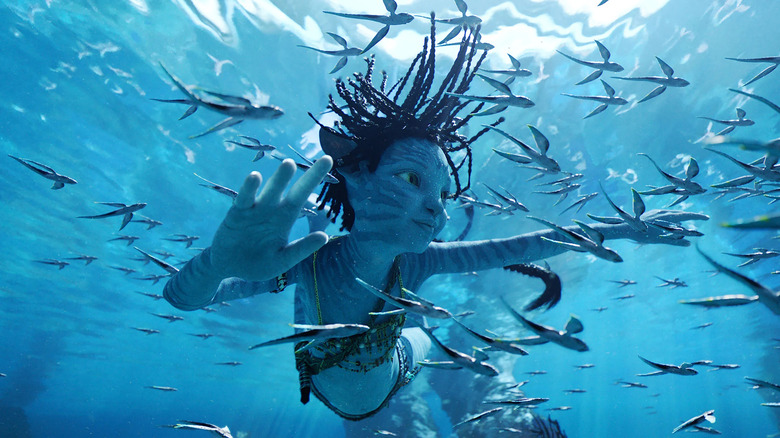Avatar: The Way Of Water Is James Cameron's Plea To Protect Our Oceans
James Cameron's obsession with our oceans is perhaps his most dominant personality trait. This is reflected in many of his films, from the earliest days of his disavowed directorial debut "Piranha II," to 1989's deepwater oil drilling drama "The Abyss," more than one ocean documentary, and of course, "Titanic." Maybe even above filmmaking, studying and exploring our oceans is Cameron's most beloved pastime. The filmmaker has completed 12 dives in a submersible vessel to the "Titanic" site and completed the first solo dive to the bottom of the Mariana Trench in 2012. As Cameron put it himself in a recent interview with National Geographic:
"I've had this romance with the ocean my entire life. That has involved spending thousands of hours underwater in shallow settings and hundreds of hours underwater in deep settings."
As he has not put out a single film since 2009's "Avatar," one of the complaints often lodged by critics of Cameron and "Avatar" is that he has dedicated too much of his time to the franchise rather than giving us more films on a smaller scale. But there were many advantages that Cameron gained from continuing what he had started. The resources afforded to the sequel of the highest-grossing film of all time, even during a shakeup in studio ownership from Disney's Fox acquisition, empowered Cameron to create an aquatic experience that may exceed actual scuba diving. In the same interview, Cameron explained another added benefit of extending his homegrown franchise:
"The reason that I went down the path of making a series of films in the same universe is because I thought that what I needed to say artistically — to communicate with people — I could do within that framework."
With "The Way of Water," Cameron's message is not hidden.
Cameron's life philosophy
Being a strong advocate for conservation, who has called to increase the federal budget for ocean science, it is almost surprising that James Cameron did not make the ocean more central to his first "Avatar" film. But with how stunningly Cameron was able to render Pandora's oceans by dedicating 13 years to the sequel, we might forgive him. Cameron told National Geographic that he intended to distinguish "The Way of Water" from its predecessor:
"Obviously, shifting from the rainforest, which was the focus of the first film, to the ocean, [there] is, between the lines, a plea for the protection and conservation and celebration of our oceans. Hopefully we can turn back from a path that is putting the oceans under stress. I don't even like to use the term "stress": It's used a lot in conservation, [but] if you consider fourth-stage cancer 'stress' yeah, it's 'stress.'"
Cameron's "Avatar" sequel is not just about the current state of our oceans. It is also about how they've changed over time and how life has changed with them. Cameron's attention to detail in crafting an impossibly vast ecosystem of alien sea creatures has the effect of making the audience believe that Pandora is not only real but has existed for as long as our own planet. By displaying an extraterrestrial ocean in such magnificent fashion, Cameron hoped to change people's minds about how we treat our own oceans. He summarized his own goal well:
"If people see this film, and aside from the drama of the Sully family and the relationships and all these big, dramatic conflicts, if they just love the underwater experience — and they love that sense of the profusion of life and the magic and mystery — then maybe it will reconnect them with what we are presently losing here on this planet."

